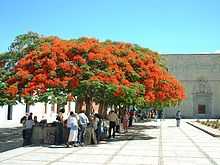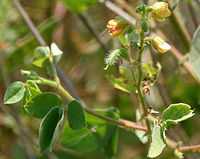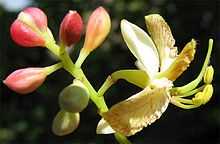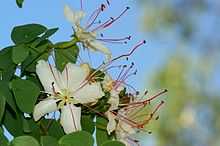Caesalpinioideae
| Caesalpinioideae | |
|---|---|
 | |
| Royal Poinciana, Delonix regia | |
| Scientific classification | |
| Kingdom: | Plantae |
| (unranked): | Angiosperms |
| (unranked): | Eudicots |
| (unranked): | Rosids |
| Order: | Fabales |
| Family: | Fabaceae |
| Subfamily: | Caesalpinioideae |
| Tribes | |
| Synonyms | |
| |
_W3_IMG_3339.jpg)
Caesalpinioideae is a botanical name at the rank of subfamily, placed in the large family Fabaceae or Leguminosae. Its name is formed from the generic name Caesalpinia. It is known also as the Peacock Flower family.
The Caesalpinioideae are mainly trees distributed in the moist tropics. Their flowers are zygomorphic, but are very variable. Nodulation is rare in this subfamily, and where it does occur nodules have a primitive structure.
Because the Papilionoideae and Mimosoideae arose from within the Caesalpinioideae,[1] the Caesalpinioideae is paraphyletic. Therefore, it is likely to be split into several subfamilies, although it is not yet clear what those subfamilies should be.[1]
In some classifications, for example the Cronquist system, the group is recognized at the rank of family, Caesalpiniaceae.
The subfamily may be classified in four tribes, Caesalpinieae, Cassieae, Cercideae and Detarieae. The tribe Cercideae has sometimes been included in the subfamily Faboideae (aka Papilionoideae) in the past.
Tribe Caesalpinieae
Tribe Cassieae

Subtribe Dialiinae |
Subtribe Cassiinae
Subtribe CeratoniinaeSubtribe DuparquetiinaeSubtribe Labicheinae |
Tribe Cercideae
Subtribe Bauhiniinae
|
Subtribe Cercidinae
|
Tribe Detarieae

About 81 genera of predominantly African distribution.
Phylogenetics
Caesalpinioideae, as traditionally circumscribed, is paraphyletic. Several molecular phylogenies have shown that the other two subfamilies of Fabaceae (Faboideae and Mimosoideae) are both nested within Caesalpinioideae.[3][4][5]
| Fabales |
| |||||||||||||||||||||||||||||||||||||||||||||||||||||||||||||||||||||||||||||||||||||||||||||||||||||||||||||||||||||||||||||||||||||||||||||||||||||||||||||||||||||||||||
| |
Asterisks (*) indicate clades traditionally assigned to Caesalpinioideae.
References
| Wikimedia Commons has media related to Caesalpinioideae. |
| Wikispecies has information related to: Caesalpinioideae |
- ↑ 1.0 1.1 Martin F. Wojciechowski, Johanna Mahn, and Bruce Jones (2006). "Fabaceae". The Tree of Life Web Project.
- ↑ Some sources treat Lasiobema as a synonym of Phanera.
- ↑ Bruneau A, Forest F, Herendeen PS, Klitgaard BB, Lewis GP (2001). "Phylogenetic Relationships in the Caesalpinioideae (Leguminosae) as Inferred from Chloroplast trnL Intron Sequences". Syst Bot 26 (3): 487–514. doi:10.1043/0363-6445-26.3.487.
- ↑ Bruneau A, Mercure M, Lewis GP, Herendeen PS. (2008). "Phylogenetic patterns and diversification in the caesalpinioid legumes". Botany 86 (7): 697–718. doi:10.1139/B08-058.
- ↑ Cardoso D, Pennington RT, de Queiroz LP, Boatwright JS, Van Wykd B-E, Wojciechowskie MF, Lavin M. (2013). "Reconstructing the deep-branching relationships of the papilionoid legumes". S. Afr. J. Bot. 89: 58–75. doi:10.1016/j.sajb.2013.05.001.
